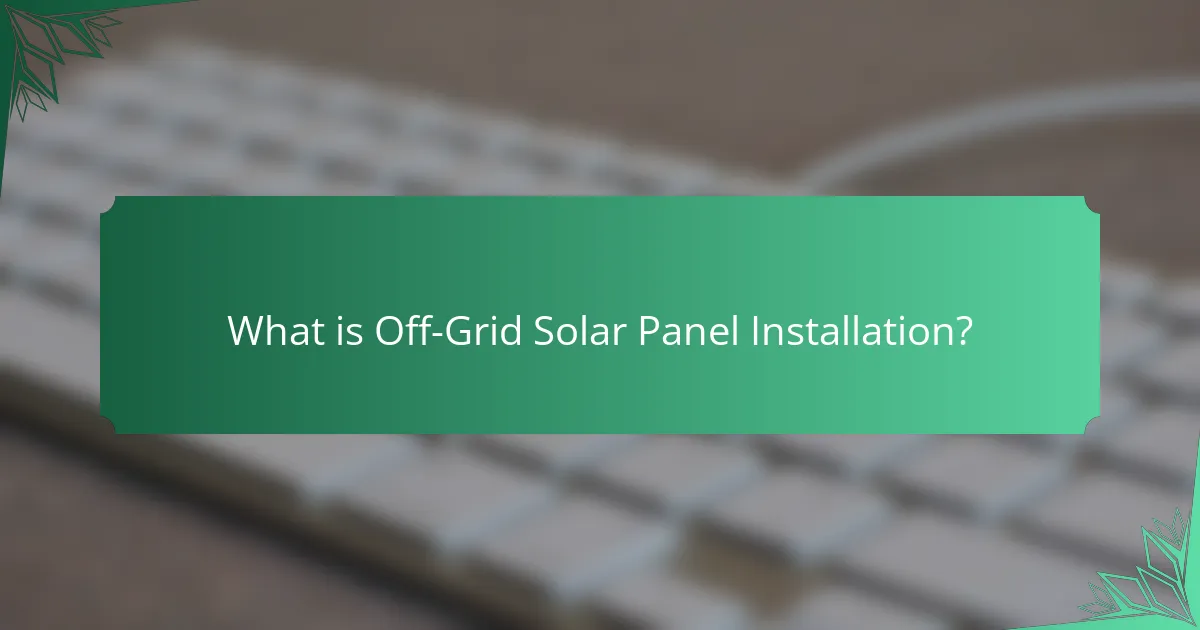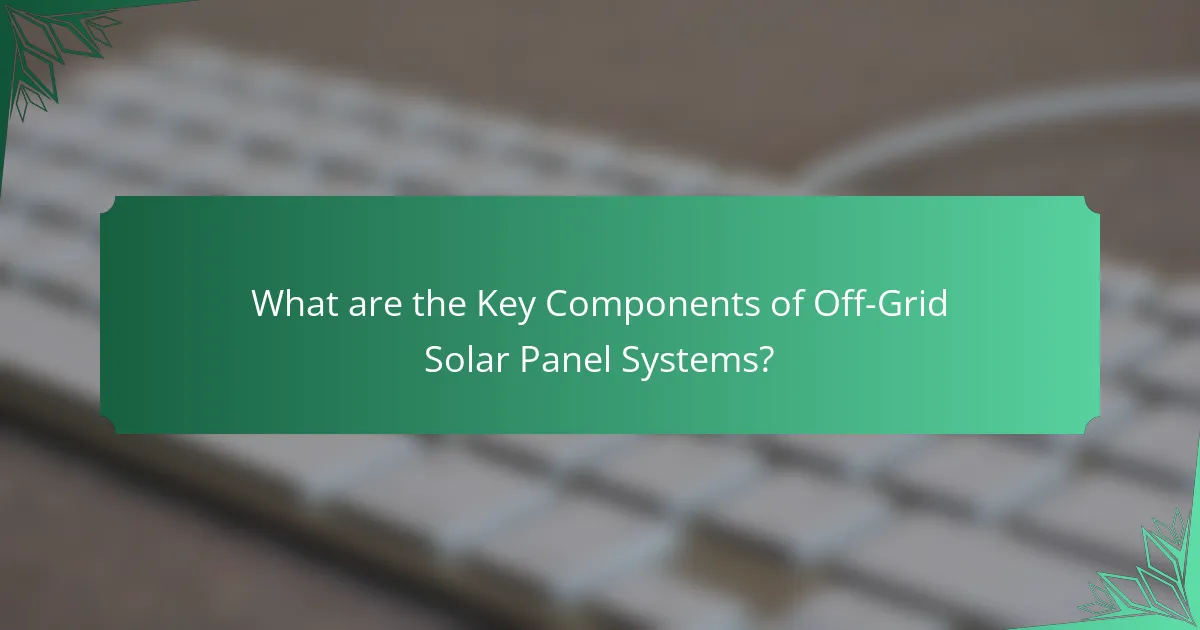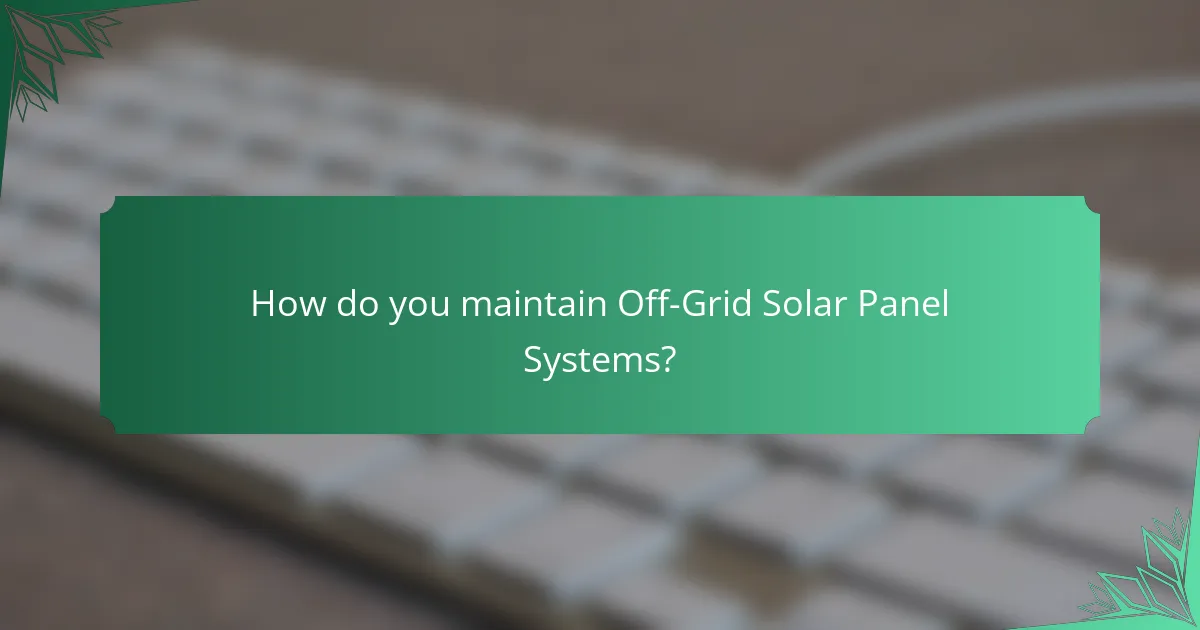
What is Off-Grid Solar Panel Installation?
Off-grid solar panel installation refers to the setup of solar energy systems that operate independently from the traditional electricity grid. These systems harness solar energy to generate electricity for homes or buildings not connected to the grid. Off-grid installations typically include solar panels, batteries for energy storage, and an inverter to convert the generated direct current (DC) into alternating current (AC) for use. This type of system provides energy autonomy and can be particularly beneficial in remote locations. According to the U.S. Department of Energy, off-grid solar systems can significantly reduce reliance on fossil fuels and lower electricity costs over time.
How does Off-Grid Solar Panel Installation differ from Grid-Tied Systems?
Off-grid solar panel installation differs from grid-tied systems in that it operates independently of the utility grid. Off-grid systems require battery storage to supply power during non-sunny periods. In contrast, grid-tied systems can draw power from the grid when solar production is insufficient. Off-grid installations often necessitate a larger solar array to meet all energy needs year-round. Grid-tied systems typically have lower initial costs due to the absence of battery storage. Maintenance requirements also differ; off-grid systems require regular battery upkeep, while grid-tied systems have fewer components to maintain. This distinction is crucial for users deciding on energy independence versus grid reliance.
What are the key characteristics of Off-Grid Solar Panel Systems?
Off-grid solar panel systems are designed to operate independently of the electrical grid. They typically include solar panels, batteries, and an inverter. These systems generate electricity from sunlight and store it for later use. Off-grid systems provide energy autonomy, making them ideal for remote locations. They require careful planning for energy needs and battery capacity. The systems often include charge controllers to manage battery charging. Off-grid solar panel systems can reduce reliance on fossil fuels. They also contribute to sustainability and environmental conservation.
Why choose Off-Grid Solar Panel Installation over traditional systems?
Off-grid solar panel installation is preferred over traditional systems for its independence from the grid. This system allows users to generate their own electricity without relying on utility companies. Off-grid systems provide energy security, especially in remote areas where grid access is limited. They can reduce electricity costs significantly over time. According to the U.S. Department of Energy, off-grid solar systems can save homeowners thousands in utility bills. Additionally, these systems promote sustainability by using renewable energy sources. They also offer flexibility in design and capacity to meet specific energy needs.
What are the benefits of Off-Grid Solar Panel Installation?
Off-grid solar panel installation provides energy independence. It allows users to generate their own electricity without relying on the grid. This can lead to significant savings on energy bills over time. According to the U.S. Department of Energy, off-grid systems can reduce energy costs by up to 75%.
Additionally, off-grid solar systems can enhance energy reliability. They provide power in remote areas where grid access is limited. This is particularly beneficial for rural homes and cabins.
Environmental benefits are also notable. Off-grid solar reduces carbon footprint by utilizing renewable energy. According to the International Renewable Energy Agency, solar energy can cut greenhouse gas emissions significantly.
Lastly, off-grid systems increase property value. Homes with solar installations often sell for more, reflecting their energy efficiency. These benefits make off-grid solar panel installation a compelling choice.
How does Off-Grid Solar Panel Installation contribute to energy independence?
Off-grid solar panel installation directly contributes to energy independence by allowing users to generate their own electricity. This system eliminates reliance on traditional power grids. Users can harness solar energy for their needs, regardless of grid availability. Off-grid systems typically include solar panels, batteries, and inverters. These components work together to store and convert solar energy into usable power. According to the U.S. Department of Energy, off-grid solar systems can reduce energy costs significantly over time. Additionally, they provide power in remote areas where grid access is limited. This autonomy fosters resilience against energy price fluctuations and outages.
What environmental advantages does Off-Grid Solar Panel Installation offer?
Off-grid solar panel installation offers significant environmental advantages. It reduces reliance on fossil fuels, leading to lower greenhouse gas emissions. According to the U.S. Environmental Protection Agency, renewable energy sources can reduce carbon dioxide emissions by up to 80%. Off-grid systems promote energy independence, minimizing the ecological footprint associated with energy transportation. They also help preserve natural habitats by reducing the need for extensive power grid infrastructure. Additionally, solar energy production has a minimal water usage compared to traditional energy sources, which can consume thousands of gallons per megawatt-hour. Overall, off-grid solar installations contribute to a more sustainable and eco-friendly energy landscape.

What are the Key Components of Off-Grid Solar Panel Systems?
The key components of off-grid solar panel systems include solar panels, charge controllers, batteries, inverters, and mounting systems. Solar panels capture sunlight and convert it into electricity. Charge controllers regulate the voltage and current coming from the solar panels to prevent battery overcharging. Batteries store the generated electricity for use when sunlight is not available. Inverters convert the stored DC electricity into AC electricity for household use. Mounting systems secure the solar panels in place, ensuring optimal exposure to sunlight. Each component plays a crucial role in maintaining an efficient off-grid solar power system.
What are the essential components needed for Off-Grid Solar Panel Installation?
The essential components needed for off-grid solar panel installation include solar panels, a charge controller, batteries, an inverter, and mounting equipment. Solar panels convert sunlight into electricity. A charge controller regulates the voltage and current from the solar panels to the batteries. Batteries store energy for use when sunlight is not available. An inverter converts the stored DC electricity into AC electricity for household use. Mounting equipment secures the solar panels in place. These components work together to create a reliable off-grid solar system.
How do solar panels function in an Off-Grid system?
Solar panels function in an Off-Grid system by converting sunlight into electricity. This electricity is generated through photovoltaic cells within the solar panels. The generated electricity can be used to charge batteries for storage. These batteries provide power when sunlight is not available, such as during the night or cloudy days. The system typically includes a charge controller to manage battery charging and prevent overcharging. Inverters convert the stored DC electricity into AC electricity for household use. Off-Grid systems are independent of the traditional power grid, making them ideal for remote locations. They require careful sizing to match energy needs with solar production. Proper installation and maintenance ensure optimal performance and longevity of the system.
What role do batteries play in Off-Grid Solar Panel Systems?
Batteries store energy generated by off-grid solar panel systems. They allow for energy use during periods without sunlight. This ensures a continuous power supply for off-grid applications. Batteries help manage energy load and consumption effectively. They provide backup power during cloudy days or nighttime. The capacity of batteries is measured in amp-hours, indicating how much energy they can store. Common battery types for these systems include lead-acid and lithium-ion. These batteries enhance the efficiency and reliability of off-grid solar energy systems.
What are the various types of solar panels used in Off-Grid systems?
Monocrystalline, polycrystalline, and thin-film are the various types of solar panels used in off-grid systems. Monocrystalline panels are made from a single crystal structure. They are known for high efficiency and space-saving designs. Polycrystalline panels consist of multiple crystal structures. They are generally less expensive but have lower efficiency compared to monocrystalline panels. Thin-film panels are lightweight and flexible. They can be integrated into various surfaces but usually have the lowest efficiency. Each type has its own advantages and disadvantages, making them suitable for different off-grid applications.
How do monocrystalline and polycrystalline panels compare for Off-Grid use?
Monocrystalline panels are generally more efficient and space-efficient than polycrystalline panels for off-grid use. Monocrystalline panels typically have an efficiency rate of 15-22%. This means they convert a higher percentage of sunlight into usable energy. Polycrystalline panels usually have an efficiency rate of 13-16%. This lower efficiency can require more space for the same energy output.
In off-grid scenarios, space is often limited. Monocrystalline panels are advantageous in these situations due to their higher power output per square foot. Additionally, monocrystalline panels perform better in low-light conditions. This can be crucial for off-grid systems that may not have consistent sunlight exposure.
The lifespan of monocrystalline panels is often longer, averaging 25 years or more. Polycrystalline panels may last around 20-25 years. This longevity can lead to better long-term investment value for off-grid users.
Cost-wise, monocrystalline panels are typically more expensive upfront. However, their efficiency and longevity can offset the initial investment over time. In contrast, polycrystalline panels are usually cheaper but may require more maintenance and replacement in the long run.
What unique attributes do thin-film solar panels offer for Off-Grid applications?
Thin-film solar panels offer several unique attributes for off-grid applications. They are lightweight and flexible, making them easier to install in various locations. Their performance in low-light conditions is superior, allowing for energy generation even in cloudy weather. Additionally, thin-film panels have a lower temperature coefficient, meaning they perform better in high temperatures compared to traditional panels. They can also be manufactured in larger sizes, which can be beneficial for specific off-grid setups. Their adaptability to different surfaces enhances installation options. Lastly, thin-film technology generally has a lower production cost, making them a cost-effective choice for off-grid systems.

How do you maintain Off-Grid Solar Panel Systems?
To maintain off-grid solar panel systems, regularly clean the panels to remove dirt and debris. Use a soft cloth or sponge with mild soap and water for cleaning. Inspect the panels for any signs of damage or wear, such as cracks or loose connections. Check the inverter and batteries for proper function and any necessary maintenance. Monitor the system’s performance to ensure it operates efficiently. Additionally, ensure that the battery bank is properly charged and maintained according to manufacturer guidelines. Regular maintenance can extend the lifespan of the system and improve energy efficiency.
What are the best practices for maintaining Off-Grid Solar Panels?
Regular cleaning of off-grid solar panels is essential for optimal performance. Dust, dirt, and debris can block sunlight and reduce energy output. It is recommended to clean the panels every few months or after significant weather events. Use a soft brush or sponge with mild soap and water for cleaning. Avoid abrasive materials that could scratch the surface.
Inspecting the panels for damage is also crucial. Check for cracks, loose connections, or corrosion. Address any issues promptly to prevent further damage.
Monitoring the system’s performance helps identify problems early. Keep track of energy production through a monitoring system. This data can indicate when maintenance is needed.
Ensuring proper shading is important as well. Trim nearby trees or vegetation that may cast shadows on the panels. This helps maintain efficiency and energy production.
Finally, maintaining the battery system is vital for off-grid setups. Regularly check battery levels and conditions. Replace batteries as needed to ensure reliable power supply.
How often should Off-Grid Solar Panels be cleaned and inspected?
Off-grid solar panels should be cleaned and inspected at least twice a year. Regular cleaning ensures optimal performance by removing dust, debris, and other obstructions. Inspections should focus on checking for physical damage, loose connections, and corrosion. In areas with heavy rainfall or dust storms, more frequent cleaning may be necessary. Regular maintenance helps prolong the lifespan of the panels and maintains energy efficiency. This schedule aligns with industry best practices for solar panel upkeep.
What common issues should be monitored in Off-Grid Solar Panel Systems?
Common issues that should be monitored in off-grid solar panel systems include battery health, inverter performance, and panel cleanliness. Battery health is crucial as it determines the system’s energy storage capacity. Regularly checking the state of charge and voltage levels helps identify potential failures. Inverter performance should be monitored to ensure efficient energy conversion. Anomalies in output voltage or frequency can indicate malfunction. Panel cleanliness affects energy absorption. Dust and debris can reduce efficiency by up to 25%. Additionally, wiring integrity should be checked for signs of wear or corrosion. Regular inspections can prevent system failures and prolong lifespan.
What tips can ensure the longevity of Off-Grid Solar Systems?
Regular maintenance is essential for ensuring the longevity of off-grid solar systems. Clean the solar panels frequently to remove dirt and debris. This helps maintain optimal energy production. Inspect the wiring and connections periodically to prevent corrosion and damage. Ensure that the batteries are properly maintained, including checking water levels and connections. Monitor the system’s performance regularly to identify any issues early. Use high-quality components to enhance durability and efficiency. Additionally, consider installing a surge protector to safeguard against electrical spikes. Following these tips can significantly extend the lifespan of off-grid solar systems.
How can proper battery maintenance enhance system efficiency?
Proper battery maintenance enhances system efficiency by ensuring optimal performance and longevity of the battery. Regular maintenance includes checking and cleaning terminals to prevent corrosion. This prevents voltage drops that can decrease system performance. Additionally, maintaining proper electrolyte levels in lead-acid batteries is crucial. It ensures the battery operates at full capacity, improving overall efficiency. Monitoring battery temperature also plays a vital role. Batteries perform better within specific temperature ranges, reducing energy loss. According to a study by the National Renewable Energy Laboratory, well-maintained batteries can improve energy storage efficiency by up to 20%. Thus, proper maintenance directly correlates with enhanced system efficiency.
What troubleshooting steps can be taken for common Off-Grid Solar Panel issues?
Check for physical obstructions blocking sunlight from the solar panels. Clean the panels if dirt or debris is present. Inspect all wiring for damage or loose connections. Ensure the inverter is functioning properly and reset it if necessary. Monitor the battery charge levels for signs of failure. Test the charge controller settings to ensure they are correct. Replace any faulty components as needed. Consult the manufacturer’s guidelines for specific troubleshooting tips.
Off-grid solar panel installation involves setting up solar energy systems that function independently from the traditional electricity grid, providing energy autonomy particularly in remote locations. Key components of these systems include solar panels, batteries for energy storage, charge controllers, and inverters, all of which work together to harness and convert solar energy into usable power. The article also covers essential maintenance tips to ensure optimal performance and longevity of off-grid solar systems, highlighting best practices for cleaning, inspecting, and monitoring system components to address common issues effectively. Additionally, it emphasizes the environmental benefits and cost savings associated with off-grid solar installations, making them a compelling choice for energy independence.